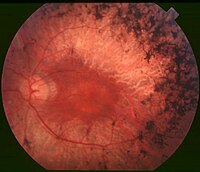
Ocular phenotype and electroretinogram abnormalities in Lafora disease and correlation with disease stage
Sign Up to like & getrecommendations! Published in 2022 at "Journal of Neurology"
DOI: 10.1007/s00415-022-10974-7
Abstract: Lafora disease (LD) is a neurodegenerative disorder featuring action and stimulus-sensitive myoclonus, epilepsy, and cognitive deterioration. Mutations in the EPM2A/EPM2B genes classically prove causative for the disease in most cases. Since full-field electroretinogram (ffERG) may… read more here.
Keywords: dysfunction; disease stage; cones rods; disease ... See more keywords

A novel compound heterozygous EPM2A mutation in a Chinese boy with Lafora disease
Sign Up to like & getrecommendations! Published in 2020 at "Neurological Sciences"
DOI: 10.1007/s10072-020-04377-7
Abstract: EPM2A has been certified as a causative gene in patients with Lafora disease (LD), which is a rare autosomal recessive and severe form of progressive myoclonus epilepsy. LD classically starts in adolescence, characterized by various… read more here.
Keywords: lafora disease; novel compound; heterozygous epm2a; compound heterozygous ... See more keywords

Modulators of Neuroinflammation Have a Beneficial Effect in a Lafora Disease Mouse Model.
Sign Up to like & getrecommendations! Published in 2021 at "Molecular neurobiology"
DOI: 10.1007/s12035-021-02285-1
Abstract: Lafora disease (LD; OMIM#274780) is a fatal rare neurodegenerative disorder characterized by generalized epileptic seizures and the presence of polyglucosan inclusions (PGs), called Lafora bodies (LBs), typically in the brain. LD is caused by mutations… read more here.
Keywords: modulators neuroinflammation; mouse model; lafora disease; disease ... See more keywords

AAV-Mediated Artificial miRNA Reduces Pathogenic Polyglucosan Bodies and Neuroinflammation in Adult Polyglucosan Body and Lafora Disease Mouse Models
Sign Up to like & getrecommendations! Published in 2022 at "Neurotherapeutics"
DOI: 10.1007/s13311-022-01218-7
Abstract: Adult polyglucosan body disease (APBD) and Lafora disease (LD) are autosomal recessive glycogen storage neurological disorders. APBD is caused by mutations in the glycogen branching enzyme ( GBE1 ) gene and is characterized by progressive… read more here.
Keywords: glycogen; adult polyglucosan; polyglucosan bodies; disease ... See more keywords

A recurrent homozygous NHLRC1 variant in siblings with Lafora disease
Sign Up to like & getrecommendations! Published in 2018 at "Human Genome Variation"
DOI: 10.1038/s41439-018-0015-9
Abstract: We report a case of two siblings with progressive myoclonus epilepsy whose parents were not consanguineous. Their clinical symptoms were typical of Lafora disease (LD), but skin biopsies revealed no Lafora bodies. Whole-exome sequencing identified… read more here.
Keywords: lafora disease; homozygous nhlrc1; variant siblings; nhlrc1 variant ... See more keywords

Brain proton magnetic resonance spectroscopy findings in a Beagle dog with genetically confirmed Lafora disease
Sign Up to like & getrecommendations! Published in 2020 at "Journal of Veterinary Internal Medicine"
DOI: 10.1111/jvim.15799
Abstract: Abstract Cortical atrophy has been identified using magnetic resonance imaging (MRI) in humans and dogs with Lafora disease (LD). In humans, proton magnetic resonance spectroscopy (1HMRS) of the brain indicates decreased N‐acetyl‐aspartate (NAA) relative to… read more here.
Keywords: lafora disease; magnetic resonance; proton magnetic; spectroscopy ... See more keywords

A retrospective case series of clinical signs in 28 Beagles with Lafora disease
Sign Up to like & getrecommendations! Published in 2021 at "Journal of Veterinary Internal Medicine"
DOI: 10.1111/jvim.16255
Abstract: Abstract Background Clinical signs and their progression in Beagles with Lafora disease are poorly described. Objectives To describe clinical signs in Beagles with Lafora disease. Animals Twenty‐eight Beagles with Lafora disease confirmed by genetic testing… read more here.
Keywords: lafora disease; signs beagles; case series; beagles lafora ... See more keywords

Trehalose Treatment in Zebrafish Model of Lafora Disease
Sign Up to like & getrecommendations! Published in 2022 at "International Journal of Molecular Sciences"
DOI: 10.3390/ijms23126874
Abstract: Mutations in the EPM2A gene encoding laforin cause Lafora disease (LD), a progressive myoclonic epilepsy characterized by drug-resistant seizures and progressive neurological impairment. To date, rodents are the only available models for studying LD; however,… read more here.
Keywords: trehalose treatment; disease; zebrafish model; model ... See more keywords

Age-Related microRNA Overexpression in Lafora Disease Male Mice Provides Links between Neuroinflammation and Oxidative Stress
Sign Up to like & getrecommendations! Published in 2023 at "International Journal of Molecular Sciences"
DOI: 10.3390/ijms24021089
Abstract: Lafora disease is a rare, fatal form of progressive myoclonus epilepsy characterized by continuous neurodegeneration with epileptic seizures, characterized by the intracellular accumulation of aberrant polyglucosan granules called Lafora bodies. Several works have provided numerous… read more here.
Keywords: male mice; oxidative stress; lafora disease; age ... See more keywords

Deciphering the Polyglucosan Accumulation Present in Lafora Disease Using an Astrocytic Cellular Model
Sign Up to like & getrecommendations! Published in 2023 at "International Journal of Molecular Sciences"
DOI: 10.3390/ijms24076020
Abstract: Lafora disease (LD) is a neurological disorder characterized by progressive myoclonus epilepsy. The hallmark of the disease is the presence of insoluble forms of glycogen (polyglucosan bodies, or PGBs) in the brain. The accumulation of… read more here.
Keywords: disease; polyglucosan accumulation; accumulation; deciphering polyglucosan ... See more keywords